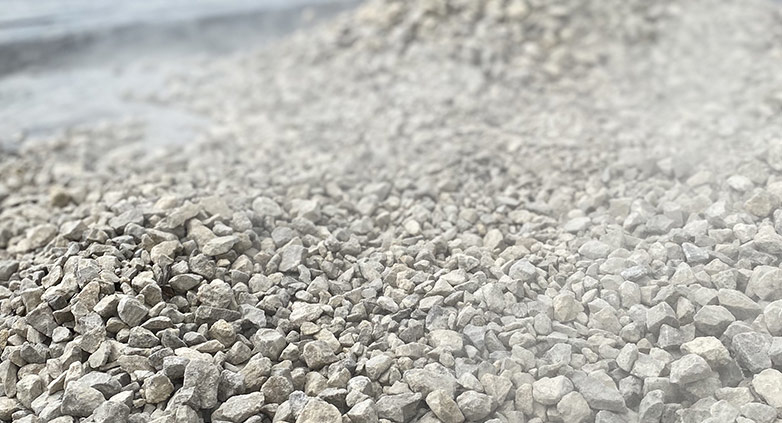Gravel Driveway on a Slope – 5 Steps for Success
A home built atop a hill may provide breathtaking vistas, but it also presents unique obstacles when it comes to landscaping the driveway.
Gravel is one of the simplest and most effective materials for paving surfaces that would support both foot and vehicle traffic because of its low cost and low maintenance needs. As a result, lots of homeowners and business owners alike make use of gravel driveways and pathways.
Having a sloped driveway as a homeowner or business owner can be difficult to maintain, especially if you wish to use gravel. Gravel exhibits particular characteristics when it is used in a driveway, and having it on a slope can compound these concerns.
To some people, gravel can not be used to pave a sloping driveway due to its propensity to migrate, disperse, and shift. There may also be fears that the gravel can be washed downhill if it rains heavily.
However, if your question is whether gravel can be laid on a slope, then the answer is yes. At the same time, to mitigate the common problems known with gravel when used on a slope, all you have to do is use the right materials and install them correctly.
So, what are the ways to keep a gravel driveway on a slope?
Below are a few methods to keep gravel driveways on a slope
- Build a Gravel Base Layer
- Form a Crown to Your Gravel Roadway or Driveway
- Create Proper Drainage
- Use a Gravel Grid
- Control Gravel With a Border
Many of these techniques can be used together to build a long-lasting surface that is resistant to erosion, flooding, ruts, and slippage. This will save you a lot of time and effort when it comes to raking or re-grading gravel surfaces.
Gravel is not the best material for a slope, even a 1:12 slope, as specified by the ADA for wheelchair ramps. It is, however, still possible, especially if you use a grid to hold the foundation layer in place and use the appropriate gravel.
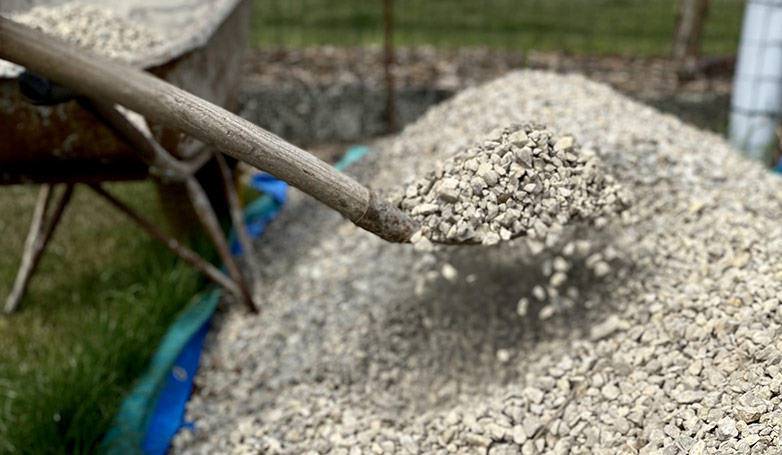
Related Articles:
- How long before you can drive on a sealed driveway?
- Milled Asphalt Driveway
- Having A Crushed Concrete Driveway
Why is it difficult to have gravel driveways on a slope?
The truth is that gravel material moves with time, making it usually unfeasible for a driveway on a slope. Naturally, gravel will roll downhill when driven over, and also when it rains. If you don’t use stabilizers, it won’t stay put.
When gravel is spread in a typical manner on a sloping gravel driveway (that’s a gravel surface dressing applied right on top of the sub-base material), it can result in the following three issues:
Problem 1- Gravel migration
When gravel is spread straight on a slope without the use of a stabilizer, the gravel appears to migrate toward the base or lowest section of the slope after some time of use. This issue is particularly with gravel driveways or slopes which automobiles use regularly.
As the gravel that’s migrated to the base of the driveway gets deeper and less stable, it becomes more difficult to drive or walk over. This deep section of gravel then migrates again across surrounding surfaces with increased pedestrian and vehicular traffic. The size and type of gravel utilized can exacerbate this migration. However, building a gravel driveway on a slope can still be accomplished.
A larger rounded pea or river gravel of 200mm will probably migrate much farther compared to smaller angular gravel of 10mm. As the loose gravel split out of the start of the slope or the entrance of the gravel driveway, the whole thing will start to look like a mess. This loose gravel is then either subsequently crushed under vehicle weight against the driveway, or ground into various surfaces, much like a tarmac road surface.
Problem 2 – Loss of surface gravel dressing
When gravel migrates, it leads to loss of gravel from the slope or driveway, exposing the sub-base material. So, if you want the surface to keep looking the way it should be, then more and more gravel ought to be placed and scattered over the surface to restore the lost gravel, and the round of gravel migration and loss begins again. This develops into a long-term maintenance problem that will recur.
Problem 3 – Formation of ruts and potholes
Ruts and potholes can form in the sub-base due to a combination of gravel movement, exposure of the material sub-base, and loss of gravel. In addition, rainwater washing down the slope, especially in severe downpours, can begin to wash the foundation of the subsurface, including some of the smaller particles, contributing to the development of ruts and potholes. The problem worsens with time as vehicles continue to travel over the same areas of the sloping driveway.
This issue is peculiar to gravel driveways on a slope, and it can not be resolved by simply adding more gravel; instead, the potholes and ruts ought to be covered with even more sub-base material, re-graded, and compressed before placing the gravel surface dressing. This, however, does not solve the problem in the long run, since the same problem will repeat in the same spots on the hill.
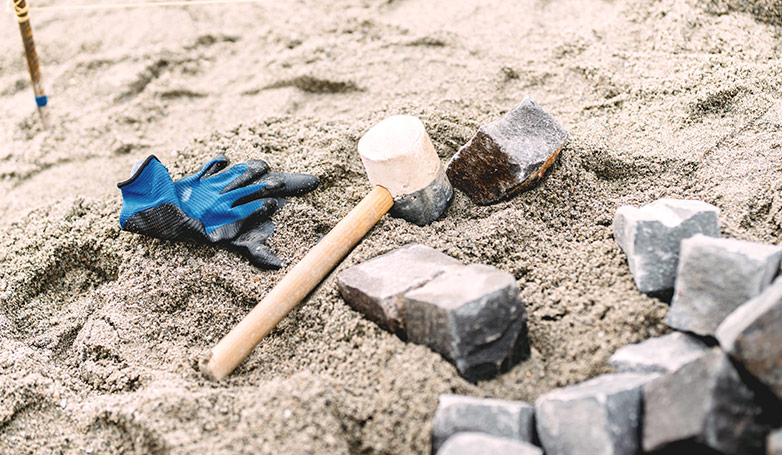
Number of ways to keep gravel driveways on a slope
Although it seems impracticable to build a gravel driveway on a hill, still there are methods to adopt in order to construct a stabilized sloped driveway using gravel.
Several of these techniques can be utilized together, to form a long-lasting surface that is resistant to ruts, erosion, slippage, and flooding. The following are a few methods to consider:
- Build a Gravel Base Layer
- Form a Crown to Your Gravel Roadway or Driveway
- Create Proper Drainage
- Use a Gravel Grid
- Control Gravel With a Border
Build a Gravel Base Layer
When constructing a gravel driveway or roadways on an uphill, it’s vital to build it to an 8–10 inches depth. This can be performed by using heavy machinery to excavate and grade the proposed roadway or driveway, or by placing gravel over an existing material with the intention to install a border after the gravel is in place.
Ensure you do the following when constructing a gravel driveway or roadway on a slope so it can withstand vehicle and foot traffic without slipping:
- Excavate up to 8-12 inches and grade the driveway. Another option is to grade the site and plan to confine gravel once it is laid. This makes the gravel driveway on a slope to be more stable.
- At this point, plan and build any culverts you want to run beneath the gravel.
- Distribute 4 inches of #3 crushed rock or stone, then roll it out to compact
- Scatter 4 inches of crushed stone #57 on the ground, then roll it out again to attain compaction.
- Finally, distribute 4 inches of crushed stone #411 on the ground, then roll to compact it.
It is worthy of note that your gravel should be laid in layers, with the use of a lawn roller in order to compact each layer. Migrating from large to smaller gravel is essential for constructing a long-lasting gravel base, which enables adequate drainage and compaction, increasing durability and making the area more resistant to flooding.
Form a Crown to Your Gravel Roadway or Driveway
When gravel is being installed, make sure it is not laid in a flat or level layer from one side to the next. Because doing this results in a water pool and increases the likelihood of gravel rolling downhill. Instead, construct your driveway or roadway with a larger elevation in the middle that gently falls to the sides. This ridge, or “crown,” will direct rainwater away from your gravel, keeping it dry and secure.
In addition, make sure you do the following if using this method:
- Create a crown along the middle of the driveway or roadway when layering and compressing the gravel.
- On either side of the crown, gradually slide the gravel downward.
- The crown should stand 3–6 inches above the margins.
- This crown will aid your gravel in shedding water and resisting erosion caused by water. Besides, it helps stabilize your gravel driveway on a slope even more.
It would be a tremendous plus if you can help your gravel shed water in any way. Vehicle activity on a waterlogged or soggy section of gravel is one of the most common causes for gravel to slide downhill.
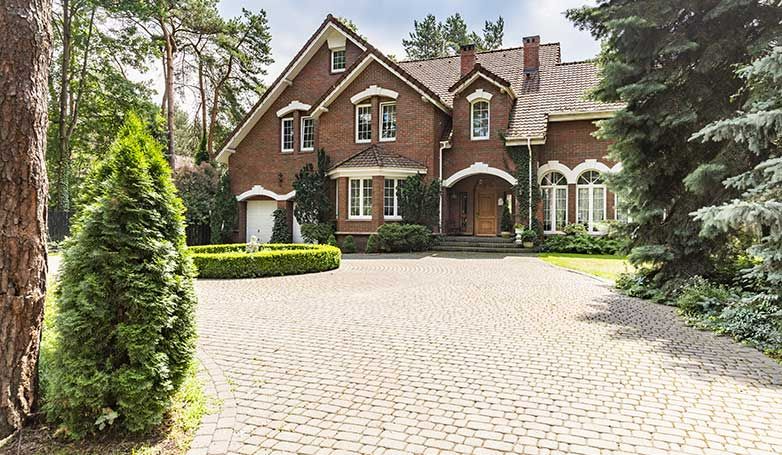
Create Proper Drainage
Gravel slides downhill or forms deep ruts as a result of flooding and washouts. A dry gravel driveway or roadway has a much better chance of staying put. So, if you’re constructing a new gravel driveway, it is ideal to install concrete culverts under the gravel to send water beneath the gravel away, rather than over the top. In addition, you can dig a trench drain across existing gravel driveways or roadways to keep them dry.
Make sure you do the following if you are adopting this method:
- Ascertain where water from the hill runs onto the gravel driveway.
- To catch the water before it hits the gravel, ensure you dig a drainage trench; downhill is the way to go.
- If you’re laying a new gravel roadway or driveway, make sure to place culvert pipes below the gravel in flood-prone locations.
- Channel your drainage trenches to route water via culverts if you have them beneath your gravel already.
The excellent thing is that since your gravel is set on a slope, you have the perfect setting for digging drainage trenches that safely move water down before it puddles on your gravel. This makes it easier to avoid flooding and washout than it would be in flat places.
Use a Gravel Grid
Another great method to keep a gravel driveway on a slope is to install a geotextile or plastic grid prior to pouring gravel. The grid’s honeycomb construction creates many “cups” that catch and hold the gravel in place. In addition, anchor the grid to the soil with rebar stakes or any similar implement prior to placing gravel if you want to achieve extra stability.
Take note of the following:
- To hold gravel in place, use a plastic grid
- It’s critical to anchor a gravel grid to the ground before spreading gravel; else, both the grid and the gravel may slide.
- Fill your grid with crushed stone #3 (which is a 1/2–2 inch gravel mix) after it has been installed.
Fill the gravel grid with #3 crushed stone and then top it over with smaller gravel like #57 and #411 to create a finer, more compact gravel driveway or roadway. Even on a steep uphill, this system will remain in place.
Control Gravel With a Border
Gravel can be contained and kept from sliding by using a border of stones, bricks, or pavers. In addition, this small wall will restrict the gravel from moving outward if you’ve constructed a deep gravel base. Don’t be concerned about the boundary acting as a water trap because flooding will not be an issue if you’ve constructed gravel from a variety of sizes and installed drainage with it.
To achieve the best result with this method, do ensure the following are in place:
- To keep your gravel driveway on a slope contained, ensure you line it with stones, concrete, or even wood.
- Your gravel can be prevented from spreading by a border, which can also keep it stable and compacted sufficiently to avoid slipping downhill.
- A border will not raise the risk of flooding if the gravel is correctly constructed with a good drainage system.
Borders can be appealing features for your property in addition to keeping your gravel in place. A well-marked and bordered driveway looks far nicer than a jagged gravel driveway that ends on both sides.
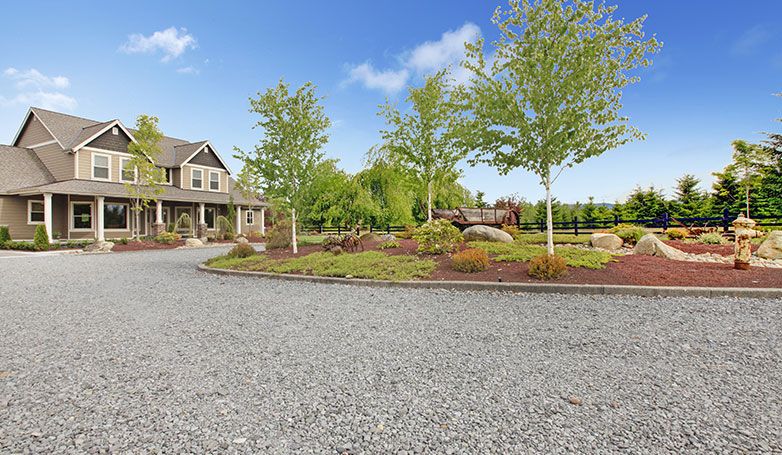
Related Articles:
How Is Gravel Applied?
Anytime you want to carry out the application of gravel on your driveway or roadway, ensure you use the three sizes of gravel available. There are three strata; the first of which consists of baseball-sized rocks, or #3 stones as they are known in the industry.
The first layer establishes a solid base for your driveway while also ensuring proper drainage. Typically, the first layer is 4 inches thick.
Another layer of 3-4 inches golf-ball-sized boulders makes up the second layer. These are the common #57 rocks which are the best gravel for a sloped driveway. The transition between the first layer and the top layer is formed by these rocks.
The uppermost layer is made up of marble-sized rocks of various colors. It all boils down to the stone you select. Also, note that each layer will require machine-crushed stone.
Conclusion
Lots of property owners hold the assertion that it is almost impracticable to keep a gravel driveway on a slope due to the migration characteristics of gravel. While this belief may not be far from the truth, it is still possible to build a stabilized driveway on a slope using gravel.
If the proper method is adopted, your sloped driveway can be constructed with gravel and it can still be as stabilized and durable as it is with the leveled ground. In all, ensure you contact a professional paving contractor if you are planning to embark on such a project for your residential property or business area.

